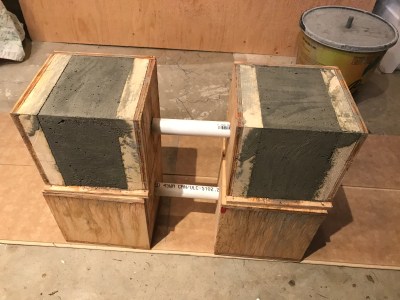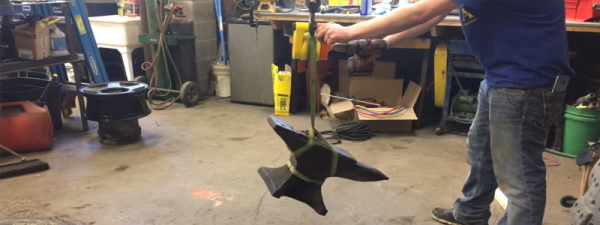Due to social distancing, gym rats throughout the world are turning everyday objects into exercise equipment to keep up the routine without actually hitting the gym. A particularly pleasing version of this are these concrete dumbbells whipped up by the unfortunately named hacker [ShitnamiTidalWave].
 If you happen to have half a bag of concrete — quick set or otherwise — out in the shed you can follow the lead on this one. But even if you’re not the kind of person who has “arm day” on your calendar (most of us here in the Hackaday bunker do not) this hack is still worth your time. Mold making is one of the uber-useful skills you should have in your hacker toolkit and [ShitnamiTidalWave] has done both an excellent job of building a mold, and of explaining the process.
If you happen to have half a bag of concrete — quick set or otherwise — out in the shed you can follow the lead on this one. But even if you’re not the kind of person who has “arm day” on your calendar (most of us here in the Hackaday bunker do not) this hack is still worth your time. Mold making is one of the uber-useful skills you should have in your hacker toolkit and [ShitnamiTidalWave] has done both an excellent job of building a mold, and of explaining the process.
Raw material for this one couldn’t be easier; each mold is made out of plywood, 2×4 stud, and nails, along with handles made of 3/4″ PVC pipe. The studs were ripped down and used to create the 45 degree chamfers at each edge. Mold-making veterans will tell you that release agent is a must and in this case rubbing the insides of the molds with wax made it a snap to pry the wooden forms off of the set concrete.
Concrete has a tendency to crack as it cures so if you’re casting large pieces like this touch-sensitive concrete countertop you might want to throw in some fiber reinforcement to the mix. If you’re keen on seeing some of the more impressive mold-making skills at work, check out how metal parts are cast from 3D-printed molds and how a master duplicates parts using silicone molds.
[via r/DIY]













